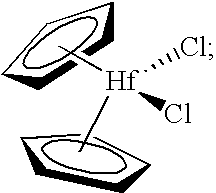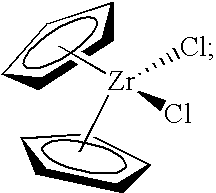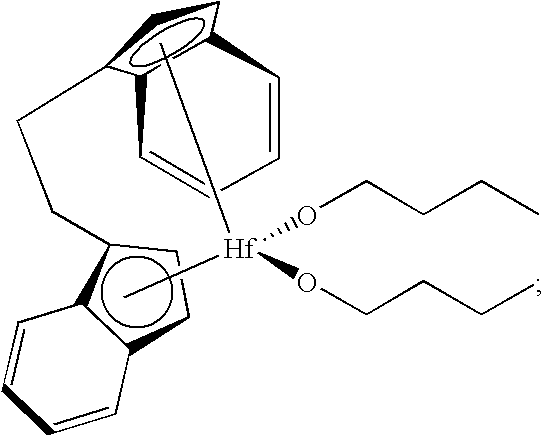Acidic activator-supports and catalysts for olefin polymerization
a technology of olefin polymerization and catalyst, which is applied in the direction of catalyst activation/preparation, physical/chemical process catalyst, chemical/physical process, etc., to achieve the effects of high polymerization activity and productivity, enhanced acidity, and increased productivity of subsequent olefin polymerization
- Summary
- Abstract
- Description
- Claims
- Application Information
AI Technical Summary
Benefits of technology
Problems solved by technology
Method used
Image
Examples
example 1
Preparation of a Fluorided Silica-Alumina Acidic Activator-Support
[0276]The silica-alumina used to prepare the fluorided silica-alumina acidic activator-support in this Example was obtained from W. R. Grace as Grade MS13-110, containing 13% alumina, having a pore volume of about 1.2 cc / g and a surface area of about 400 m2 / g. This material was fluorided by impregnation to incipient wetness with a solution containing ammonium bifluoride in an amount sufficient to equal 10 wt % of the weight of the silica-alumina. This impregnated material was then dried in a vacuum oven for 8 hours at 100° C. The thus-fluorided silica-alumina samples were then calcined as follows. About 10 grams of the alumina were placed in a 1.75-inch quartz tube fitted with a sintered quartz disk at the bottom. While the silica was supported on the disk, dry air was blown up through the disk at the linear rate of about 1.6 to 1.8 standard cubic feet per hour. An electric furnace around the quartz tube was used to i...
example 2
Preparation of a Precontacted / Postcontacted Catalyst Composition and Comparison of its Polymerization Activity with a Standard Catalyst Composition
[0277]The present invention was tested in a comparative study of a catalyst composition comprising bis(cyclopentadienyl)zirconium dichloride catalyst, triethylaluminum (TEA), monomer (ethylene) and comonomer (1-hexene), and acidic activator-support (fluorided silica-alumina), both with and without the precontacting step of the metallocene, TEA, and 1-hexene. The data obtained in this study are provided in Table 1, using an acidic activator-support of fluorided silica alumina.
[0278]A stock solution of 45 mg of bis(cyclopentadienyl)zirconium dichloride in 45 mL of dry, degassed toluene was prepared for the experiments of Table 1. Control Example 2A of Table 1 represents polymerization data obtained from the near simultaneous contacting of 5 mL of the bis(cyclopentadienyl)zirconium dichloride stock solution, 200 mg of fluorided silica alumin...
example 3
Comparison of the Polymerization Activity of Catalyst Compositions Prepared by Varying the Components that are Precontacted and Postcontacted
[0282]In Examples 3A-3D presented in Table 2, 1 mL of a 1 mg / 1 mL toluene stock solution of bis(cyclopentadienyl)zirconium dichloride was optionally treated, in various combinations, with 1 mL of 15 wt % triethylaluminum, 2 mL of 1-hexene, and 200 mg of a fluorided silica-alumina activator-support for 30 minutes before introduction of this mixture to the polymerization autoclave. The stock solution was prepared under an atmosphere of nitrogen by dissolving 45 mg of bis(cyclopentadienyl)zirconium dichloride in 45 mL of dry toluene. Polymerizations were conducted for 60 minutes in isobutane at 90° C., 550 psig of ethylene, with 20 grams of 1-hexene. A “Yes” or “No” in Table 2 indicates the presence or absence of these reagents, respectively, in the precontacted mixture in the 30 minute period prior to introduction to the autoclave.
[0283]In Exampl...
PUM
| Property | Measurement | Unit |
|---|---|---|
| period of time | aaaaa | aaaaa |
| time | aaaaa | aaaaa |
| temperature | aaaaa | aaaaa |
Abstract
Description
Claims
Application Information
 Login to View More
Login to View More - R&D
- Intellectual Property
- Life Sciences
- Materials
- Tech Scout
- Unparalleled Data Quality
- Higher Quality Content
- 60% Fewer Hallucinations
Browse by: Latest US Patents, China's latest patents, Technical Efficacy Thesaurus, Application Domain, Technology Topic, Popular Technical Reports.
© 2025 PatSnap. All rights reserved.Legal|Privacy policy|Modern Slavery Act Transparency Statement|Sitemap|About US| Contact US: help@patsnap.com



